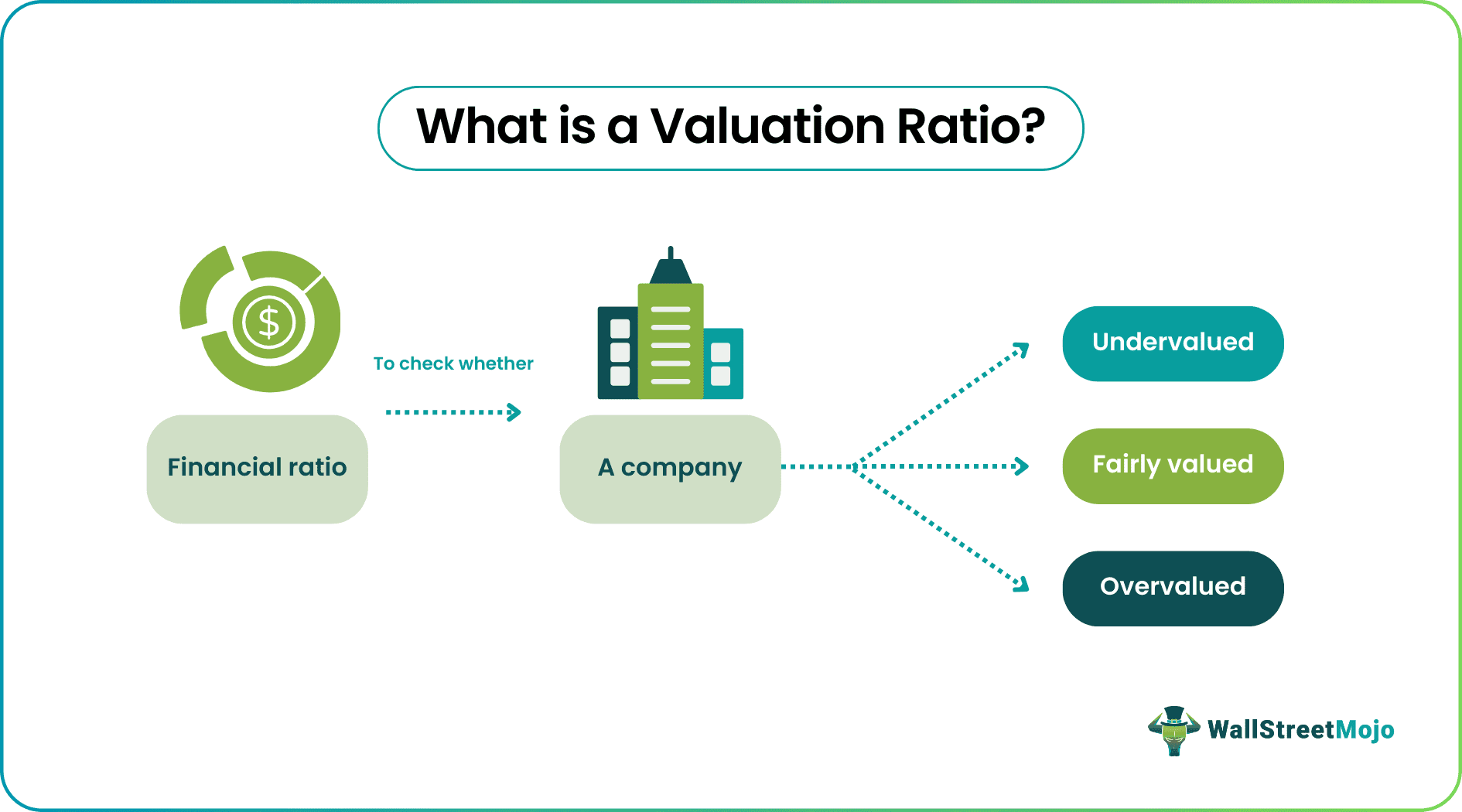Table Of Contents
Valuation Ratio Meaning
Valuation Ratio, in financial analysis, refers to the metrics that determine the company's actual worth compared to book value. The primary purpose of these rations is to find whether a particular company stock is undervalued or overhyped.

These ratios help in evaluating the relative value of a stock and provide insights into the company's market and financial performance. Individuals and entities consider this ratio as an essential tool for making investment decisions as they highlight potential investment risks involved. However, it is important to note that every firm might consider a different market valuation ratio to analyze.
Key Takeaways
- Valuation ratios are a part of financial ratios that help investors determine whether a company is true to its value. They are usually classified as overvalued, fairly valued, or undervalued.
- Ratios used for valuation determine market value, but the cost-of-revenue ratio measures the efficiency of manufacturing. Investors can learn a lot about market value and operational performance from these metrics.
- The ratios under this category include the price-to-equity (P/E) ratio, price-to-book (P/B) ratio, enterprise multiple, price-to-sales ratio, and others.
- There is no particular formula for the calculation of valuation ratios. However, investors can use the formula for listed ratios for quick analysis.
Valuation Ratio Explained
The valuation ratio is a crucial parameter in financial modeling, determining the true value of a company’s stock. As a result, investors can quickly evaluate whether a stock is overvalued or undervalued. While a high ratio can depict the presence of a bubble, it can also indicate favorable conditions when interest rates and associated risks are low. Similarly, a high stock valuation ratio indicates a high dividend yield.
The valuation ratio analysis is not a new metric. It has been in the picture for long, and the most significant presence of such ratio analyses was observed during the late 1990s and early 2000s. This was the period when the price-to-earnings (P/E) ratio for stock valuation had a vital influence on market performance. By the end of 1996, these ratios witnessed a significant increase, indicating positive market sentiment. However, there were significantly fewer such instances during the Great Recession. This historical disparity emphasizes the importance of these ratios in influencing market cycles and investor sentiment.
Various factors influence the valuation ratio analysis, including industry type, market size, debt levels, growth potential, and events. So, if any of these overweigh the firm, the ratio can fluctuate. For instance, a firm with high leverage will have a higher ratio. A high ratio indicates a higher dividend yield and a lower ratio makes the stock lucrative for the investor. However, analysts sometimes take a valuation ratio or multiples to determine the relative value of a stock as well.
List
Some of the popular valuation ratios or multiples are as follows:
#1 - Price-To-Book (P/B) Ratio
It indicates the relationship between the market price of a stock and the book value of a firm's equity. Here, book value is derived by deducting liabilities from assets. This ratio allows investors to compare a firm's market capitalization to the book value to check if a company is undervalued.
#2 - Price-To-Earnings (P/E) Ratio
This ratio indicates how much an investor pays for a stock for every dollar profit earned. When this ratio is high, it indicates that the stock price of a company is higher concerning the earnings, and hence it is overvalued. On the other hand, if the ratio is low, it denotes the stock price is lower for the earnings, and hence, the company and its stocks are undervalued.
#3 - Price-To-Sales (P/S) Ratio
The P/S ratio denotes the price investors pay for every dollar sale (or revenue). It is an investment valuation ratio, which indicates to investors where they should invest and where they must not. If this ratio is lower, the chances of an investment turning profitable are higher, and vice-versa.
#4 - Price-To-Cash Flow Ratio
This ratio compares the share price of a stock to the cash flow per share. A lower value of this ratio indicates that the company's stocks are undervalued, which means the assets of the company deserve better value. Anything below 10 is considered a good price-to-cash flow ratio.
#5 - EV-To-EBITDA
Also known as the Enterprise Multiple, this ratio indicates the value of a company. It is the Enterprise Value (EV) studied against the Earnings Before Interest Tax Depreciation and Amortization (EBITDA). It is one of the most significant metrics to consider when it comes to acquisitions. One party figures out the value of another company to check how many EBITDA multiple one must pay to acquire the company in question.
#6 - Dividend Ratio
The dividend ratio focuses explicitly on the dividend earned on every share bought by the shareholders. It assesses what shareholders receive as dividends to what the company's net income is. If this ratio is above 100, it indicates the company is paying its shareholders more than its net income.
Formula
As various ratios are used for calculating valuation, there is no specific formula for analysis. Investors and analysts can use any of the below-mentioned formulas for to derive a ratio that could help them figure out how the stocks of a company are valued.

Calculation Example
Let us look at the calculation example for a better understanding.
Suppose Britts, a wealthy merchant, considers investing in a large-cap automobile company amid analyst skepticism and stock volatility. He conducted a valuation analysis using information from annual reports and market share prices. The values are given below:
- Price per share = $50
- Earnings per share = $3
- Sales per share = $10
- Enterprise Value = $100 million
- EBITDA = $20 million
- Book Value per share = $15
This is how he calculated the ratios based on the formulas:
- Price to Earnings Ratio (P/E Ratio): $50 / $3 ≈ 16.67
- Price to Sales Ratio (P/S Ratio): $50 / $10 = 5
- Enterprise Multiple: $100,000,000 / $20,000,000 = 5
- Price to Book Value Ratio: $50 / $15 ≈ 3.33
From the analysis, Britts discovered that the firm was overvalued due to excess stock hype. He would have to pay more for a stock that is not worth it.
Importance
Valuation ratios exist in various forms. Therefore, it is important to know which one to use for what purpose. However, these ratios are always helpful in figuring out the proper valuation of the company. The points below reflect the importance of these ratios in assessing the value of a stock, an investment, or a company as a whole.
- As there are various stocks available to invest in, these ratios allow investors to select the right one for better returns.
- It helps compare if a company's stocks are overvalued, undervalued, or rightly valued.
- Stock investors keep track of these valuations to predict the possible fluctuations in stock value in the future. This helps them buy a stock and hold it until the period when the prices go up or are expected to move up.
- Numerous valuation ratios are available to users. They can reach a satisfactory valuation conclusion by trying more than one ratio type at the same time.

